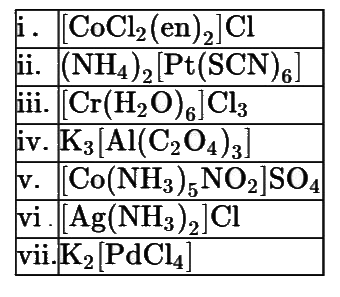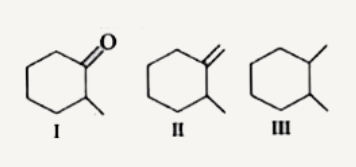The compound which exhibits linkage isomerism is :
[Cr(NH3)6]3+
[Co(NH3)6]3+
[Co(NH3)5NO2]Cl2
[Pt(NH3)2Cl2]
The correct Answer is:C
To determine which compound exhibits linkage isomerism, we first need to understand what linkage isomerism is and identify the relevant ligands.
Step 1: Understand Linkage Isomerism
Linkage isomerism occurs when a ligand can attach to the metal center through different atoms. This typically happens with ambidentate ligands, which have two different atoms that can coordinate to the metal ion. Common examples of ambidentate ligands include:
- NO2- (can bind through nitrogen or oxygen)
- SCN- (can bind through sulfur or nitrogen)
Step 2: Identify the Compounds
Now, we need to look at the options provided in the question to identify which compound contains an ambidentate ligand. The question mentions four options, and we need to analyze them.
Step 3: Analyze the Options
Let's consider the ligands in the options:
1. Option A: Contains ligands that do not exhibit linkage isomerism.
2. Option B: Contains ligands that do not exhibit linkage isomerism.
3. Option C: Contains NO2- as a ligand, which can bind through either nitrogen or oxygen, thus exhibiting linkage isomerism.
4. Option D: Contains ligands that do not exhibit linkage isomerism.
Step 4: Conclusion
Based on the analysis, the compound that exhibits linkage isomerism is Option C, which contains the ligand NO2-.
Final Answer
The compound which exhibits linkage isomerism is Option C: (Co(NH3)5(NO2))Cl2.
---
Linkage isomerism occurs when a ligand can attach to the metal center through different atoms. This typically happens with ambidentate ligands, which have two different atoms that can coordinate to the metal ion. Common examples of ambidentate ligands include:
- SCN- (can bind through sulfur or nitrogen)
Now, we need to look at the options provided in the question to identify which compound contains an ambidentate ligand. The question mentions four options, and we need to analyze them.
Let's consider the ligands in the options:
2. Option B: Contains ligands that do not exhibit linkage isomerism.
3. Option C: Contains NO2- as a ligand, which can bind through either nitrogen or oxygen, thus exhibiting linkage isomerism.
4. Option D: Contains ligands that do not exhibit linkage isomerism.
Based on the analysis, the compound that exhibits linkage isomerism is Option C, which contains the ligand NO2-.
The compound which exhibits linkage isomerism is Option C: (Co(NH3)5(NO2))Cl2.
Topper's Solved these Questions
- BOOK - ICSECHAPTER - COORDINATION COMPOUNDS EXERCISE - EXERCISE (PART - II DESCRIPTIVE QUESTIONS) (VERY SHORT ANSWER TYPE QUESTIONS)67videos
COORDINATION COMPOUNDS
- BOOK - ICSECHAPTER - COORDINATION COMPOUNDS EXERCISE - EXERCISE (PART - II DESCRIPTIVE QUESTIONS) (SHORT ANSWER QUESTIONS)74videos
COORDINATION COMPOUNDS
- BOOK - ICSECHAPTER - COORDINATION COMPOUNDS EXERCISE - EXERCISE (PART - I OBJECTIVE QUESTIONS)22videos
COORDINATION COMPOUNDS
- BOOK - ICSECHAPTER - CHEMISTRY-2020 EXERCISE - Question (Answer the following question)4videos
CHEMISTRY-2020
- BOOK - ICSECHAPTER - d- AND- f- BLOCK ELEMENTSEXERCISE - ISC EXAMINATION QUESTIONS (PART-II)(DESCRIPTIVE QUESTIONS)15videos
d- AND- f- BLOCK ELEMENTS
Similar Questions
Knowledge Check
- Question 1 - Select One
The comopound which exhibits coordination isomerism is:
A[Pt(NH3)2Cl2]BK3[Fe(CN)6]CK4[Fe(CN)6]D[Cr(NH3)6][Co(CN)6] - Question 2 - Select One
The compound which may exhibit tautomerism:
A B
B C
C DAll of these
DAll of these - Question 3 - Select One
Which of the following compounds exhibits linkage isomerism?
A[Co(en)3]Cl3B[Co(NH3)6][Cr(en)3]C[Co(en)2(NO2)Cl]BrD[Co(NH3)5Cl]Br2
Which of the following compound will exhibit geometrical isomerism ?
View SolutionWhich of the following compounds will exhibit geometrical isomerism?
View SolutionWhich of the following compounds will exhibit geometrical isomerism?
View SolutionThe compound which does not exhibit optical isomerism is
View SolutionWhich of the following compounds will exhibit geometrical isomerism?
View Solution



